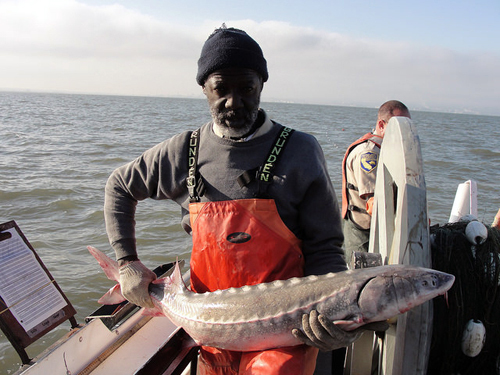Anglers Urged to Return Overdue 2015 Sturgeon Fishing Report Cards

by California Department of Fish & Wildlife
3-14-2016
Website
The California Department of Fish and Wildlife (CDFW) is reminding sturgeon anglers to return their 2015 Sturgeon Fishing Report Cards as required by law. Although the deadline to report their catch was Jan. 31, so far only about 13,000 (or 27 percent) of the 48,338 report cards sold have been returned. The sport fishing regulations require that all sturgeon anglers return their report cards, even those who did not encounter sturgeon and who did not fish for white sturgeon.
Without the data gleaned from the roughly 35,000 late report cards, CDFW’s scientific understanding of the white sturgeon and green sturgeon populations is incomplete. This makes it harder for scientists to assess the white sturgeon population and to document accidental catch of the threatened green sturgeon. Addressing the uncertainty could mean new harvest restrictions and certainly means more expense.
“Anglers who return their report cards are providing very good data that is otherwise unavailable. They are also helping to protect the white sturgeon fishery and rebuild both sturgeon populations,” said Marty Gingras, CDFW Sturgeon Program Manager. “Anglers who do not return report cards — especially the many thousands of avid sturgeon anglers — are complicating those efforts. We’re asking anglers to send the information to us now, even though the deadline has passed.”
Anglers can return the overdue report cards by mail to the address printed on the card or — until April 1 — use the CDFW website at www.wildlife.ca.gov/licensing/fishing#758846-harvest-reporting. In continuing efforts to both encourage anglers to return their 2015 Sturgeon Fishing Report Cards as required by law and to understand more about the missing data, CDFW used the Automated License Data System and a scientific phone survey to contact more than 6,000 avid sturgeon anglers during the last few months. The phone survey showed that many avid sturgeon anglers are choosing not to (rather than forgetting to) return their report cards and that substantial catch data is being withheld. Both reasons were previously considered plausible but had never before been quantified.
White sturgeon and green sturgeon are anadromous, meaning they move from the salt and brackish water to spawn in freshwater. They are both native California species and can live to be more than 100 years old. California’s sturgeon populations were substantially reduced by commercial fishing in the 19th century and the recreational and commercial sturgeon fisheries were (with minor exceptions) closed from 1901 through 1953. Only recreational fishing for sturgeon has been allowed since 1954, and that fishery has become increasingly restricted over time in an effort to rebuild the populations and protect the fishery. Green sturgeon is a threatened species and may not be fished for or harvested.
Without the data gleaned from the roughly 35,000 late report cards, CDFW’s scientific understanding of the white sturgeon and green sturgeon populations is incomplete. This makes it harder for scientists to assess the white sturgeon population and to document accidental catch of the threatened green sturgeon. Addressing the uncertainty could mean new harvest restrictions and certainly means more expense.
“Anglers who return their report cards are providing very good data that is otherwise unavailable. They are also helping to protect the white sturgeon fishery and rebuild both sturgeon populations,” said Marty Gingras, CDFW Sturgeon Program Manager. “Anglers who do not return report cards — especially the many thousands of avid sturgeon anglers — are complicating those efforts. We’re asking anglers to send the information to us now, even though the deadline has passed.”
Anglers can return the overdue report cards by mail to the address printed on the card or — until April 1 — use the CDFW website at www.wildlife.ca.gov/licensing/fishing#758846-harvest-reporting. In continuing efforts to both encourage anglers to return their 2015 Sturgeon Fishing Report Cards as required by law and to understand more about the missing data, CDFW used the Automated License Data System and a scientific phone survey to contact more than 6,000 avid sturgeon anglers during the last few months. The phone survey showed that many avid sturgeon anglers are choosing not to (rather than forgetting to) return their report cards and that substantial catch data is being withheld. Both reasons were previously considered plausible but had never before been quantified.
White sturgeon and green sturgeon are anadromous, meaning they move from the salt and brackish water to spawn in freshwater. They are both native California species and can live to be more than 100 years old. California’s sturgeon populations were substantially reduced by commercial fishing in the 19th century and the recreational and commercial sturgeon fisheries were (with minor exceptions) closed from 1901 through 1953. Only recreational fishing for sturgeon has been allowed since 1954, and that fishery has become increasingly restricted over time in an effort to rebuild the populations and protect the fishery. Green sturgeon is a threatened species and may not be fished for or harvested.
More Reports
California Department of Fish & Wildlife Reports
for Thursday, March 10th, 2016• Abandoned lobster traps and hoop nets
• If duck hasn’t built a nest yet, can I catch and eat it?
• Fishing and trapping crayfish at the same time

3-7-2016
The Crystal Lake Hatchery in eastern Shasta County reopened to the public Thursday after being closed due to a major...... Read More
